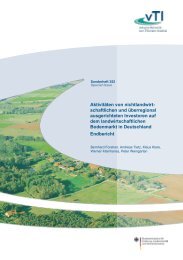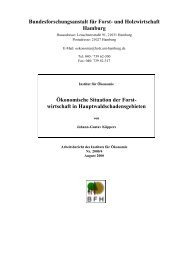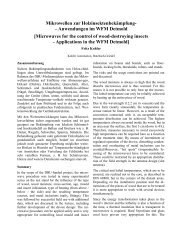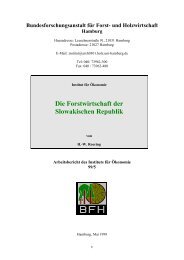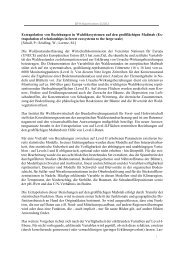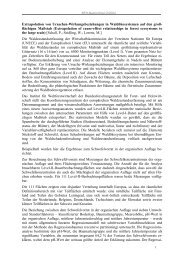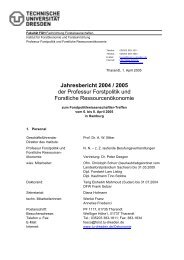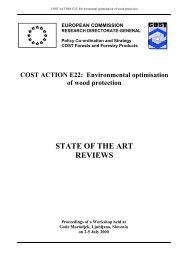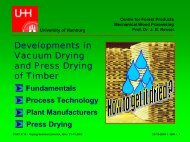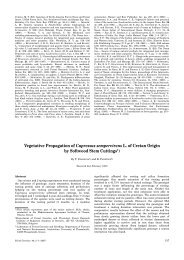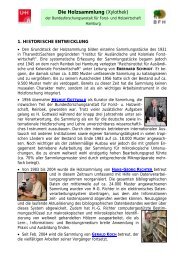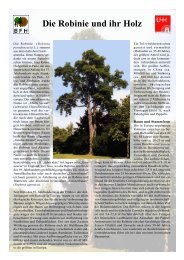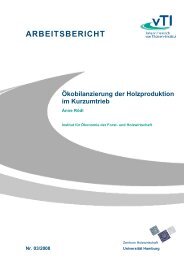Landbauforschung vTI Agriculture and Forestry ... - 1. Januar 2008
Landbauforschung vTI Agriculture and Forestry ... - 1. Januar 2008
Landbauforschung vTI Agriculture and Forestry ... - 1. Januar 2008
Create successful ePaper yourself
Turn your PDF publications into a flip-book with our unique Google optimized e-Paper software.
G. Najjar, F. Godlinski, N. Vassilev, B. Eichler-Löbermann / <strong>L<strong>and</strong>bauforschung</strong> - <strong>vTI</strong> <strong>Agriculture</strong> <strong>and</strong> <strong>Forestry</strong> Research 3 2012 (62)77-82 79<br />
Before sowing, 2 g of RP powder <strong>and</strong> 25 ml of mycorrhizal<br />
inoculum were added to the respective treatments<br />
at a depth of 10 cm. The RP contained 13.1 % of P (30 %<br />
P 2 O 5 ) <strong>and</strong> came from Kola Peninsula, Russia. The extractability<br />
of P in the RP powder was 6.7 % in water, <strong>and</strong><br />
57.3 % in ammonium citrate, whereas the pH value was<br />
8.4. The commercial mycorrhizal product consisted of Glomus<br />
etunicatum, Glomus intraradices <strong>and</strong> Glomus claroideum<br />
with a spore number of 10 5 per l litre. The carrier<br />
material was exp<strong>and</strong>ed clay with a grain size of 2 to 4 mm<br />
<strong>and</strong> a pH of 7.5. Per pot 25 ml of this product was used.<br />
The PF-DR54 inoculum was prepared by growing in liquid<br />
R2A medium (Difco) at 25 °C for 36 h, suspended in 0.1 M<br />
MgSO 4 buffer, washed twice <strong>and</strong> re-suspended in distilled<br />
water at about 10 8 cfu per ml. After appearance of the<br />
second leaf the PF suspension was applied to the respective<br />
treatments (10 8 cfu per plant). The pots were irrigated<br />
with distilled water. In order to consider the possible effect<br />
of experimental time, the plants in the first experiment<br />
(June-Exp) were harvested after 55 days, the plants in the<br />
second (August-Exp) after 45 days. The plants were cut<br />
above ground, oven-dried at 60 °C for 72 h, weighed <strong>and</strong><br />
ground for chemical analyses. At harvest soil samples were<br />
taken <strong>and</strong> dried for further analyses.<br />
Table 1:<br />
Characteristics of the soil used for planting<br />
Texture P<br />
mg kg -1<br />
K<br />
mg kg -1<br />
Mg<br />
mg kg -1<br />
OM<br />
%<br />
s<strong>and</strong>y loam 48.2 6<strong>1.</strong>0 234 2.80 6.86<br />
Plant <strong>and</strong> soil analyses<br />
Shoot-biomass P concentrations were measured after<br />
dry-ashing using the vanadad-molybdate method (Page<br />
et al., 1982). Shoot biomass N concentrations were measured<br />
by using the Kjeldahl digestion method modified according<br />
to Jones et al. (1991). Nutrient uptake per pot was<br />
calculated by multiplying shoot biomass (g) with shoot nutrient<br />
concentration (mg g -1 ). The organic matter content<br />
in soil was determined after ashing in an oven at 550 °C.<br />
Soil contents of double lactate soluble P, K <strong>and</strong> Mg (P dl , K dl ,<br />
Mg dl ), as well as pH (CaCl 2 ) were measured according to<br />
Blume et al. (2000). Phosphates extracted with double lactate<br />
solution represent the plant available P (Schachtschabel<br />
<strong>and</strong> Beyme, 1980). K dl <strong>and</strong> Mg dl concentrations were<br />
measured with a flame? photometer. P shoot biomass <strong>and</strong><br />
P dl were measured with a spectral photometer at 430 nm.<br />
pH<br />
Statistical procedure<br />
Data were subjected to the GLM (General Linear Model)<br />
procedure of SPSS version 15. Treatment effects were<br />
tested by one-way analysis of variance followed by Duncan’s<br />
multiple range test used for multiple comparisons.<br />
Mean differences were considered significantly different<br />
at p < 0.05.<br />
Results <strong>and</strong> discussion<br />
In both experiments the yield of maize <strong>and</strong> beans significantly<br />
increased when RP was combined with P. fluorescens<br />
<strong>and</strong> AMF together, whereas no yield effect was<br />
found after the RP addition only compared to the control.<br />
Single application of either AMF or Pseudomonas with RP<br />
only resulted in higher yields for beans in the June experiment,<br />
when the plants were harvested at the end of flowering<br />
stadium.<br />
Table 2:<br />
DM yields of maize <strong>and</strong> beans (g per pot) in pot experiments (sowing<br />
in June <strong>and</strong> August <strong>2008</strong>)<br />
Treatment Maize Beans<br />
June August June August<br />
Con 55.5 a 38.9 a 29.6 a 18.8 a<br />
RP 57.6 a 40.6 ab 3<strong>1.</strong>6 ab 19.6 a<br />
RP+PF 59.4 ab 40.4 ab 33 b 20.1 a<br />
RP+AMF 57.9 a 40.9 ab 33.8 b 20 a<br />
PR+PF+AMF 63.5 b 42.5 b 34.4 b 2<strong>1.</strong>6 b<br />
Different letters within a column indicate significant differences between the treatments;<br />
p < 0.05 (Duncan), Con = control, RP = rock phosphate, PF = Pseudomonas<br />
fluorescens, AMF = arbuscular mycorrhizal fungi<br />
With regard to the P uptake, for maize significantly<br />
higher values compared to the control were only found<br />
in the combined RP+PF+AMF treatment. For beans higher<br />
treatment effects were observed. In the June experiment P<br />
uptake by beans was raised when RP was combined with<br />
dual microorganism inoculation (RP+PF+AMF) as well as<br />
with one inoculation alone (RP+PF <strong>and</strong> RP+AMF). The RP<br />
without AMF or PF resulted in 10 % higher P uptake compared<br />
to the control, but this difference was not significant.<br />
In the August experiment however, all RP treatments<br />
resulted in higher P uptakes of beans compared to the<br />
control. This strongly indicates that beans were more efficient<br />
in using P from rock phosphate than maize. These<br />
results are in accordance with other studies emphasising



